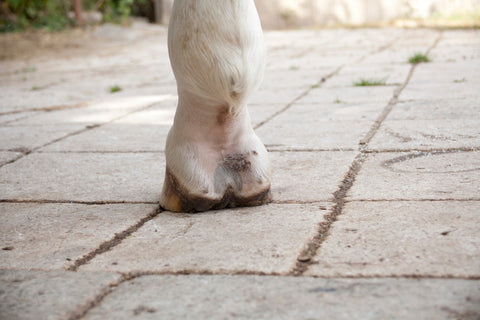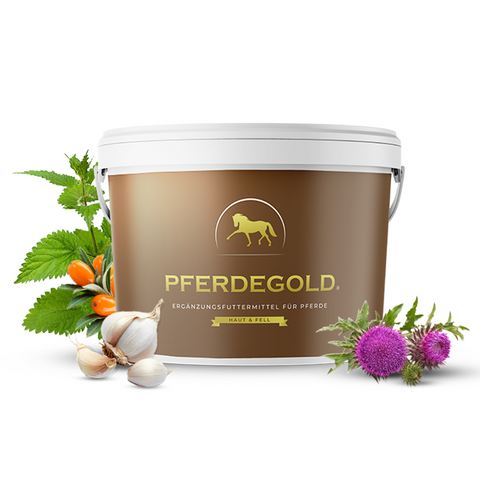
Florian ist aufgewachsen auf einem Bauernhof. Umgeben von Pferden, entdeckte er früh seine Faszination für diese majestätischen Tiere. Inspiriert von seiner reitbegeisterten Mutter, entwickelte er das Nahrungsergänzungmittel - Pferdegold. Seine tiefe Verbundenheit zur Natur und die leidenschaftliche Hingabe zu Pferden trieben ihn an, sein Unternehmen zu gründen.
Mud fever in horses: Recognizing, treating & successfully preventing
Mud fever in horses is one of the most common and persistent Skin diseases in the fetlock. This inflammatory skin lesion can lead to painful wounds and presents horse owners with significant challenges.
Mud fever is more than just a cosmetic problem – it is a complex skin disease that often results from a combination of different factors. Once this inflammation becomes chronic, the Effects often long-lasting and serious than initially expected.
In this comprehensive counselor You will learn everything you need to know about Mud fever in horses : from the first warning signs to the causes and proven treatment methods and effective prevention strategies .
Mud fever in the fetlock - early detection prevents chronic progression
What is mud fever in horses?
Mud fever is an inflammatory skin disease that primarily occurs in the pastern and is characterized by redness, swelling, crusting, and painful cracks.
The formation mechanism:
In mud fever, the natural skin barrier is damaged by various factors, allowing bacteria, fungi, or other pathogens to penetrate. The resulting inflammation leads to the characteristic skin changes and often to painful restrictions in movement.
Forms of mud fever:
Depending on the severity, a distinction is made between acute mud fever (sudden inflammation with severe swelling), chronic mud fever (long-lasting changes with thickening of the skin) and warty mud fever (nodular growths in severe cases).
Depending on the severity, the spectrum ranges from slight redness and scaling to weeping wounds to deep, painful skin cracks with secondary bacterial infection.
Recognizing mud fever: correctly interpreting warning signals
The insidious nature of mud fever: It often develops gradually and is initially overlooked as a harmless skin irritation. However, early detection is crucial for successful treatment.
🚨 Immediate warning signs:
- Redness and swelling in the fetlock
- Crust formation and scaly skin changes
- Painful cracks with possible wetness or bleeding
- Lameness or stiff gait due to pain
👁️ Detect early development:
- Increased warmth in the fetlock
- Slight swelling after humid conditions
- Sensitivity when touching the affected area
- Increased flaking and rough skin
💡 Pro tip: Mud fever is particularly common in the winter months, when damp and muddy conditions weaken the skin barrier. Preventive checks are especially important during this time.
Cleanliness and dryness prevent mud fever
How does mud fever develop? Understanding the causes
Mud fever is caused by a complex interplay of moisture, poor hygiene, skin irritation, and bacterial colonization. Horses with long manes and sensitive skin are particularly susceptible.
⚡ The main causes:
Mud fever is usually caused by persistent moisture such as muddy paddocks, damp bedding or constantly wet conditions that weaken the natural skin barrier.
Often, husbandry errors are also responsible: inadequate stable hygiene, infrequent leg cleaning or overlooking the first skin changes all contribute to the development of the condition.
Horses with dense mane, sensitive skin, weak immune systems or horses kept on pasture during wet seasons are particularly at risk.
What to do if you have mud fever? First aid and treatment
Consistent action is crucial! The earlier treatment begins, the better the chances of recovery and the lower the risk of chronic disease.
🛑 Immediate measures:
Immediate action is required at the first signs of mud fever: First, the affected areas must be carefully cleaned and dried. Crusts should only be removed once they have softened. A dry, clean place to stand is essential until the disease heals.
🚨 Call a vet if:
Severe swelling, deep skin cracks, purulent discharge, or if there is no improvement after a week of care. Severe mud fever requires professional treatment.
💉 Proven therapeutic approaches:
Treatment begins with thorough cleaning and disinfection of the affected areas. Depending on the severity, antiseptic ointments, antibiotic treatment, or cortisone-containing preparations follow. Consistently keeping the area dry and clean is important.

Horses with excessively long feces are more susceptible to mud fever
Prevention: How to protect your horse from mud fever
Prevention is the best protection! With consistent stable hygiene and regular leg care, most cases of mud fever can be prevented.
📈 Optimize posture and care:
Optimal stable hygiene:
- Dry, clean bedding and regular changes
- Well-drained paddocks without waterlogging
- Daily cleaning of the legs after grazing
Preventive leg care:
- Regular but not excessive washing of the legs
- Thorough drying, especially of the pastern
- Trimming excessively long hair
🔍 Regular checks:
- Daily inspection of the fetlocks
- Documentation of skin changes
- Adapting care to weather conditions
Supportive nutrition for healthy skin
A targeted diet can contribute to preventative skin health. By providing essential nutrients, the skin barrier is strengthened from within.
🔧 Important nutrients for healthy skin:
- Zinc: Essential for wound healing and skin regeneration
- Biotin: Important for healthy skin and coat structure
- MSM: Natural sulfur source for strong skin structures
- Methionine: Sulphur-containing amino acid for healthy skin and coat quality

Healthy through nutrients - Natural support from within
The optimal nutrient combination in Pferdegold Skin & Coat
- Zinc: Highly available for optimal skin regeneration and wound healing
- Biotin: High dose for strong skin and coat quality
- MSM: Natural sulfur source for healthy skin structures
- Methionine: Sulphur-containing amino acid for firm skin and horny structures
⚠️ Important note: Pferdegold Skin & Coat is not related to the disease described in this article. It does not treat any disease and is not a substitute for veterinary diagnosis or treatment. This supplement can only be used as preventative support for healthy horses.

Pferdegold® Skin & Coat
This specially developed supplement supports natural skin function and promotes a healthy, shiny coat. Made in Germany, grain-free, and backed by a 30-day money-back guarantee.
Order nowTreatment: The path to complete healing
Patience is key! Mud fever requires systematic and persistent treatment until the skin changes heal completely.
📅 Typical treatment duration:
The duration of treatment varies greatly depending on the severity and chronicity. Acute mud fever can heal in just 1-2 weeks, while chronic cases require 4-8 weeks. Severe warty mud fever can last several months – consistency and patience are crucial here.
🎯 Treatment steps:
- Daily cleaning and disinfection (weeks 1-2)
- Removal of crusts and necrotic tissue
- Drug treatment depending on the cause (weeks 3-4)
- Supportive care and dry keeping (weeks 5-8)
- Preventive follow-up care to avoid relapses

Thorough cleaning is the first step in healing
Frequently asked questions about mud fever
How long does it take for mud fever to heal?
The healing time varies depending on the severity: 1-2 weeks for acute mud fever, up to 8 weeks for chronic cases.
Can mud fever recur?
Yes, mud fever tends to relapse, especially if the causes have not been eliminated or the skin barrier is still weakened.
Is mud fever contagious to other horses?
Mud fever itself isn't directly contagious, but the bacteria that cause it can be transmitted. Hygiene measures are important.
Conclusion: Successfully prevent and treat mud fever
Mud fever is one of the most common skin problems in horses, but can be successfully controlled through consistent prevention and proper treatment. It requires attention, systematic care, and, above all, patience during the healing process.
The most important findings:
- Early detection through daily leg checks is crucial
- Dry, clean housing and hygiene provide the best protection
- Rapid treatment prevents chronic progression
- Consistent care is more important than expensive special treatments
The key is prevention: With optimal Stable hygiene, regular leg care and targeted support through skin-promoting nutrition can significantly reduce the risk.
Perfect for your horse: Pferdegold® supplementary feed!
These specially developed supplements support your horse's diet and provide it with natural nutrients. Made in Germany, grain-free and drug-free, they come with a 30-day money-back guarantee.
IMPORTANT:
Pferdegold is not a substitute for veterinary diagnosis or treatment. The information contained in this article is for general informational purposes only and is intended to help improve your horse's well-being.
Pferdegold Skin & Coat is not related to the disease described in this article. It does not treat any disease and is not a substitute for veterinary diagnosis or treatment. This supplement can only be used as preventative support for healthy horses.


















